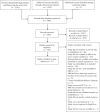Differential sensitivity of mindfulness questionnaires to change with treatment: A systematic review and meta-analysis
- PMID: 31368738
- PMCID: PMC6793937
- DOI: 10.1037/pas0000744
Differential sensitivity of mindfulness questionnaires to change with treatment: A systematic review and meta-analysis
Erratum in
-
"Differential sensitivity of mindfulness questionnaires to change with treatment: A systematic review and meta-analysis": Correction to Baer et al. (2019).Psychol Assess. 2019 Oct;31(10):1263. doi: 10.1037/pas0000777. Psychol Assess. 2019. PMID: 31580135 Free PMC article.
Abstract
[Correction Notice: An Erratum for this article was reported in Vol 31(10) of Psychological Assessment (see record 2019-58643-005). The article should have been published under the terms of the Creative Commons Attribution License (CC BY 3.0). Therefore, the article was amended to list the authors as copyright holders, and information about the terms of the CC BY 3.0 was added to the author note. In addition, the article is now open access. All versions of this article have been corrected.] In support of the construct validity of mindfulness questionnaires, meta-analytic reviews have reported that scores increase in mindfulness-based interventions (MBIs). However, several studies have also found increased mindfulness scores in interventions with no explicit mindfulness training, raising a question about differential sensitivity to change with treatment. We conducted a systematic review and meta-analysis of 37 randomized controlled trials in which mindfulness questionnaires were administered before and after an evidence-based MBI and a nonmindfulness-based active control condition. The central question was whether increases in mindfulness scores would be greater in the MBI than in the comparison group. On average, participants in MBIs showed significantly greater pre-post changes in mindfulness scores than were seen in active control conditions with no explicit mindfulness elements, with a small overall effect size. This effect was moderated by which mindfulness questionnaire was used, by the type of active control condition, and by whether the MBI and control were matched for amount of session time. When mindfulness facet scores were analyzed separately, MBIs showed significantly greater pre-post increases than active controls in observing, nonjudging, and nonreactivity but not in describing or acting with awareness. Although findings provide partial support for the differential sensitivity of mindfulness questionnaires to change with treatment, the nonsignificant difference in pre-post change when the MBI and control were matched for session time highlights the need to clarify how mindfulness skills are acquired in MBIs and in other interventions and whether revisions to mindfulness questionnaires would increase their specificity to changes in mindfulness skills. (PsycINFO Database Record (c) 2019 APA, all rights reserved).
Figures



References
-
- Baer R. A. (2011). Measuring mindfulness. Contemporary Buddhism, 12, 241–261. 10.1080/14639947.2011.564842 - DOI

